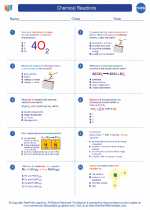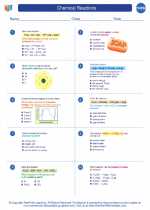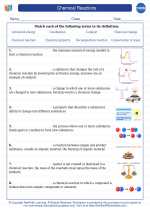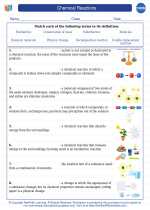Single Replacement Reactions
In chemistry, single replacement reactions, also known as single displacement reactions, occur when an element replaces another element in a compound. These reactions are characterized by the transfer of an atom or group of atoms from one reactant to the other. The general form of a single replacement reaction can be represented as:
A + BC → AC + B
Where A is the element that displaces B from the compound BC, resulting in the formation of a new compound AC and the release of element B. It's important to note that single replacement reactions only occur if the replacing element is more reactive than the displaced element.
Key Points to Remember:
- Single replacement reactions involve the replacement of one element by another in a compound.
- The activity series of metals and non-metals can be used to predict whether a single replacement reaction will occur.
- Metals replace metals in compounds, and non-metals replace non-metals in compounds.
- The reactivity of elements plays a crucial role in determining whether a single replacement reaction will take place.
Examples of Single Replacement Reactions:
Example 1:
Zn + 2HCl → ZnCl2 + H2
In this reaction, zinc (Zn) replaces hydrogen (H) in hydrochloric acid (HCl) to form zinc chloride (ZnCl2) and hydrogen gas (H2).
Example 2:
2Na + 2H2O → 2NaOH + H2
Here, sodium (Na) replaces hydrogen (H) in water (H2O) to produce sodium hydroxide (NaOH) and hydrogen gas (H2).
Study Guide for Single Replacement Reactions:
To understand and master single replacement reactions, follow these study tips:
- Memorize the activity series of metals and non-metals, which helps in predicting whether a single replacement reaction will occur.
- Practice writing and balancing chemical equations for single replacement reactions.
- Understand the concept of reactivity and how it determines which elements can replace others in compounds.
- Work through plenty of examples to reinforce your understanding of single replacement reactions.
- Review the properties of metals and non-metals to better comprehend their reactivity in single replacement reactions.
By following these study tips and practicing regularly, you can gain a solid understanding of single replacement reactions and confidently tackle problems related to this topic.
[Single Replacement Reactions] Related Worksheets and Study Guides:
.◂Chemistry Worksheets and Study Guides High School. Chemical Reactions

 Worksheet/Answer key
Worksheet/Answer key
 Worksheet/Answer key
Worksheet/Answer key
 Worksheet/Answer key
Worksheet/Answer key
 Worksheet/Answer key
Worksheet/Answer key
 Worksheet/Answer key
Worksheet/Answer key
 Vocabulary/Answer key
Vocabulary/Answer key
 Vocabulary/Answer key
Vocabulary/Answer key
 Vocabulary/Answer key
Vocabulary/Answer key
